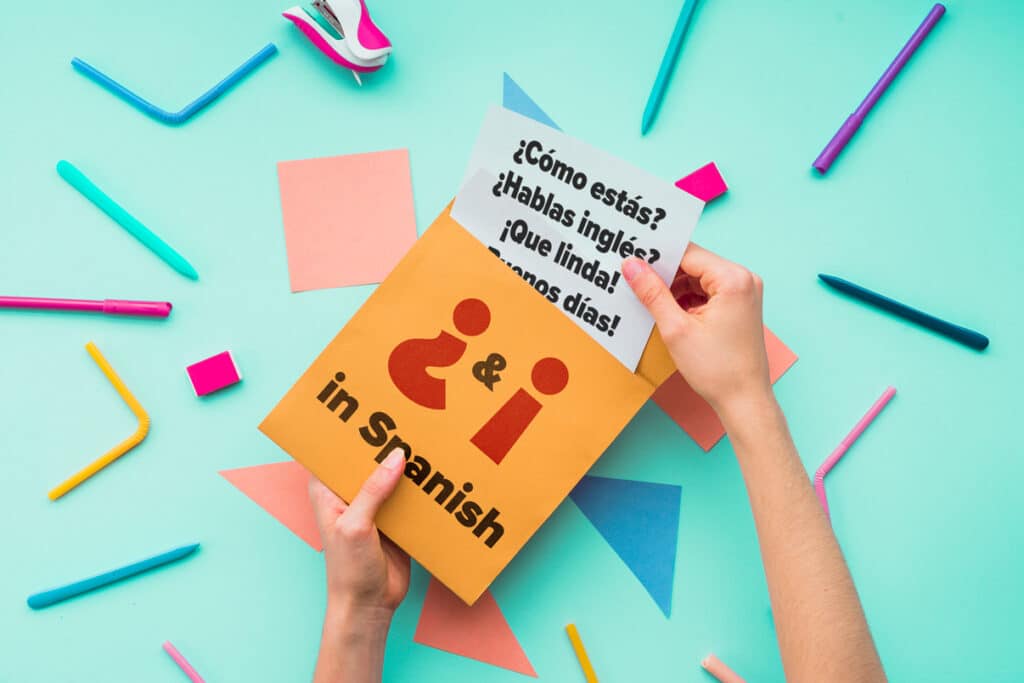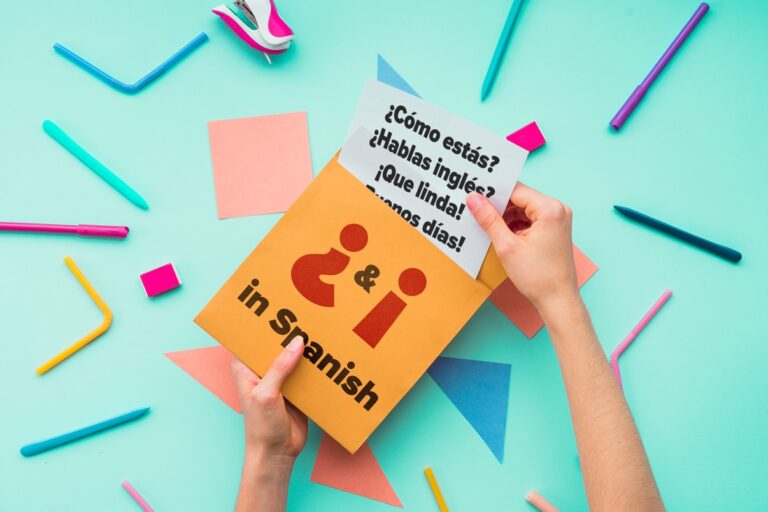
You’re reading a Spanish text and suddenly, ¡wham! You’re greeted by an upside down punctuation mark.
This can be a bit of a surprise if you’ve never run into an upside down question mark or an upside down exclamation point before.
There’s no real secret to mastering this topic—you just need to know why and how to use upside down punctuation marks in Spanish.
In this post, you’ll learn why Spanish has upside down punctuation, when to use it and how to type inverted question marks and exclamation points on any device.
¡Vámonos! (Let’s go!)
Contents
Download:
This blog post is available as a convenient and portable PDF that you
can take anywhere.
Click here to get a copy. (Download)
The History of Inverted Punctuation Marks
Did you know that the upside down exclamation point was originally proposed for use in English?
In the mid-1600s, British clergyman and philosopher John Wilkins suggested using an inverted exclamation mark to show irony. This, as you may know, didn’t quite take off (though the internet age has adopted the inverted smiley face in its stead).
The use of inverted punctuation marks in written Spanish actually didn’t happen until later than Wilkins’ ill-fated attempt at the same. The Real Academia Española (Royal Spanish Academy) originally suggested the use of inverted question and exclamation marks to indicate an upcoming question or exclamation in the mid-1700s.
As with many new rules, the language was pretty slow in adopting this as standard. Still, by the 1900s, the upside down punctuation marks had become a ubiquitous symbol of Spanish writing. Today, they’re part of formal writing in Spanish (both Latin American and European) as well as in other Iberian languages such as Galician and Catalan—though they’re often omitted for short questions and exclamations, and in more casual writing.
Why Use an Upside Down Question Mark
In Spanish, inverted punctuation is used to communicate clearly in written form. An upside down question mark is placed at the beginning of a sentence that’s a question, to show that there’s a question coming up.
Take a look at these two English sentences:
We’re going to the theater.
Are we going to the theater?
Now look at the same sentences in Spanish:
Vamos al teatro.
¿Vamos al teatro?
In English, it’s clear when a question is coming up because the question word starts the sentence that poses a question. In Spanish, however, the two sentences are identical. Instances like this are why the inverted question mark was introduced into the written Spanish language!
The upside down question mark is used for the following reasons:
- To indicate a question
- To replace an interrogative word
- To signal a change in tone
Read on to see more involved explanations and examples.
To Indicate a Question
The simplest function is that an inverted question mark tells you a question is coming.
¿Cómo estás?
(How are you?)
¿Quieres un poco más de agua?
(Would you like some more water?)
¿A qué hora cierra la tienda?
(What time does the store close?)
To Replace an Interrogative Word
We typically use an interrogative word at the beginning of a question, but we don’t have to. When speaking, tone implies the missing interrogative. In writing, that job falls to the question marks.
¿Dónde está el baño? → ¿El baño?
(Where is the bathroom?) → (The bathroom?)
¿Cuándo llega el tren? → ¿El tren?
(When is the train arriving?) → (The train?)
¿Pasarías la sal? → ¿La sal?
(Would you pass the salt?) → (The salt?)
To Signal a Change in Tone
In Spanish, declarative statements and questions may only differ by punctuation. If you’re reading aloud, the upside down question mark tells you when to raise your tone for a question.
Juan va a la florería. → ¿Juan va a la florería?
(Juan goes to the flower shop. ) → (Is Juan going to the flower shop?)
Hablas inglés. → ¿Hablas inglés?
(You speak English.) → (Do you speak English?)
El autobús llega muy tarde. → ¿El autobús llega muy tarde?
(The bus is very late.) → (Is the bus very late?)
Why Use an Upside Down Exclamation Point
Unlike the slightly more nuanced upside down question mark, there’s really only one reason to use an inverted exclamation point in Spanish:
To signal an exclamation.
The upside down exclamation point simply tells the reader that this is an exclamatory sentence.
You don’t have to wait until the end of the sentence to find out the tone was meant to be excited the whole time!
¡Que linda!
(How cute!)
¡Me encanta esta canción!
(I love this song!)
¡Lo siento, no puedo oírte!
(Sorry, I can’t hear you!)
How To Use Inverted Punctuation Marks
Use Two Punctuation Marks
When writing questions or exclamatory sentences in Spanish, you’ll just need to remember to use two punctuation marks—one at the beginning and one at the end.
For example:
¿Cómo te llamas?
(What is your name?)
¡Vamos a llegar tarde a la fiesta!
(We’re going to be late for the party!)
Inverted Punctuation in the Middle of a Sentence
By now, you know the upside down question mark is placed at the beginning of a question. However, that doesn’t always mean that it’s placed at the beginning of a sentence.
Same goes for the upside down exclamation point. These inverted marks should be placed at the beginning of the question or exclamatory phrase.
For example:
Si bailamos, ¿ellos también van a bailar?
(If we dance, will they dance, too?)
Te veo el martes, ¡adiós!
(I’ll see you Tuesday, bye!)
Inverted Question and Exclamation Marks Together
Don’t be surprised to see passages that use both inverted question marks and inverted exclamation points.
¡Buenos días! ¿A dónde vas, Susana?
(Good morning! Where are you going, Susana?)
¡Ayuda! ¿A dónde va con mi bolso?
(Help! Where is she going with my purse?)
¡Ahora no! ¿Podemos hablar después?
(Not now! Can we talk later?)
You may also see upside down question marks and exclamation points used together.
Note that the punctuation may show up in either order, according to the Real Academia Española (Royal Spanish Academy) which maintains the standards for proper Spanish usage.
¡¿Cómo me llamaste?!
(What did you call me?!)
¡¿El perro se escapó?!
(The dog ran away?!)
¿¡Dónde has estado!?
(Where have you been?!)
Inverted Punctuation in Informal Writing
In recent years, upside down punctuation is becoming less common in casual writing.
When texting or writing informally, Spanish speakers won’t usually use it. That means you probably don’t have to, either.
However, you should expect to see inverted punctuation in books, standard writing and movie subtitles. You’ll also need to use it when writing in Spanish class!
You can further familiarize yourself with how inverted punctuation marks are used in formal and informal situations by reading in Spanish. Visit a Spanish-language social media page or read a news article. How do the two differ in their use of inverted punctuation?
You can even find upside down punctuation in Spanish subtitles. Using a program like FluentU allows you to see Spanish and English dual-language subtitles that are 100% accurate (unlike, for instance, YouTube closed captions).
FluentU teaches Spanish through authentic videos like movie clips, music videos, commercials and more, where you can see upside down question marks and upside down exclamation points in action.
Be on the lookout for these unique punctuation marks in any Spanish writing you come across, and you’ll soon have a better understanding of how they’re used in different situations.
How To Type Upside Down Punctuation Marks
Using a Mac
To type the upside down question mark:
1. Hold down the Option and Shift keys.
2. Press the question mark key.
To type the upside down exclamation point:
1. Hold down the Option key.
2. Press 1 (the button with the standard exclamation point).
Using a PC
To get the inverted question mark:
1. Hold down the Alt key.
2. Type 168.
To get the inverted exclamation point:
1. Hold down the Alt key.
2. Type 0161.
If you’re using an international keyboard:
- hold the right Alt key and tap the question mark key for the upside down question mark.
- hold the right Alt key and tap the exclamation point key for the upside down exclamation point.
To type other Spanish punctuation marks, Useful Shortcuts provides a handy reference table.
Using an iPhone or iPad
For the upside down question mark:
1. Find the conventional question mark on the device’s keyboard.
2. Press and hold the question mark. A little bubble will appear.
3. In the bubble, you can select either the standard question mark or the upside down mark.
Follow similar steps to find the upside down exclamation point:
1. Find the standard exclamation point on the keyboard.
2. Press and hold it until the bubble appears.
3. Within the bubble, you can choose between the conventional or the upside down exclamation point.
Using an Android Device
To find inverted punctuation marks:
1. Select “sym” (for “symbols”) on your keyboard.
2. Navigate to the second page.
3. Select the inverted question mark or exclamation point.
Using a Spanish Keyboard App
For more precise typing, you can use an app that makes all Spanish punctuation—including the upside down ones—readily accessible. You might try:
- Spanish Keyboard, for Android devices
- Gboard, available for Android or iOS devices
- Spanish Keyboard & Translator, for Android or iOS devices
Now that you understand the hows and whys of using upside down punctuation in Spanish, you won’t be surprised when you come across these marks in the wild!
Download:
This blog post is available as a convenient and portable PDF that you
can take anywhere.
Click here to get a copy. (Download)



